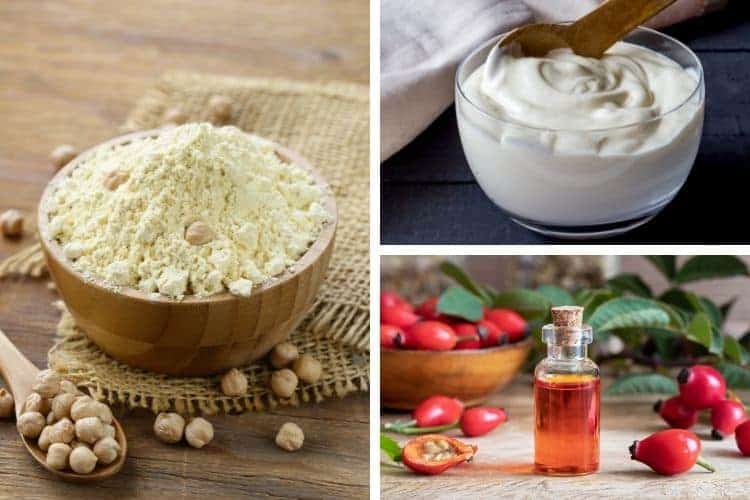
Like all skin types, sensitive skin benefits from exfoliation. However, since sensitive skin is also much more prone to irritation, it requires an exfoliator that is gentle and nourishing/soothing. So, in this article we’re going to dive into how to exfoliate sensitive skin naturally, including:
- Which ingredients to use.
- Ingredients to avoid on sensitive skin.
- How often to exfoliate sensitive skin.
- Recipes you can try.
NATURAL EXFOLIANTS THAT ARE GOOD FOR SENSITIVE SKIN
There are two types of natural exfoliants that can be used on sensitive skin: physical or manual exfoliants (such as bean or grain flours) and chemical exfoliants (such as goat milk). The chemical exfoliants are usually gentler and more effective because they don’t require manual pressure and they also contain soothing ingredients that nourish the skin.
Let’s take a look at some of the natural exfoliants that you can use on sensitive skin as well as their benefits.
1. Flours (Oat, Chickpea or Rice)
Oat, chickpea and rice flour are some of the best, and most gentle, physical exfoliants that you can use at home.
As opposed to other flours – like coconut, which is more grainy – these three flours have more of a powdery feel. This makes them less likely to create micro cuts on the surface of the skin.
HOW TO USE:
- Combine with water or a floral water (like rose water) to make a paste. Then gently massage onto wet skin.
2. Colloidal Oatmeal
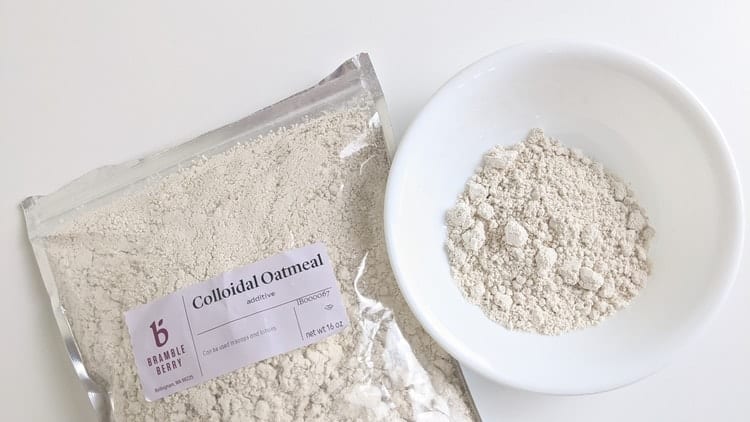
Colloidal oatmeal is rolled oats that have been ground to a very fine powder. Now, if you’re thinking that this sounds like oat flour, it’s not. Colloidal oatmeal contains bran (which is generally absent in oat flour), which makes it more beneficial for the skin.
Here are a few reasons why you’d want to exfoliate sensitive skin with colloidal oatmeal:
- Natural source of the antioxidant ferulic acid, which is an exfoliant that is used in chemical peels (also quite common in vitamin C serums). When compared with other popular acids like glycolic and lactic acid, research shows that ferulic is the most gentle and safest (source).
- Contains vitamin E, an antioxidant that supports cell turnover and helps to reveal healthier, glowing skin.
- Has emollient properties that soften and smoothen the skin.
- Rich in natural sugars that act as humectants (i.e. they attract water to the skin).
- When combined with water, colloidal oats create a protective barrier on the skin. This is especially soothing for dry, sensitive and inflamed skin (and it’s no wonder that colloidal oatmeal is in so many eczema remedies, for example).
HOW TO USE
- Make sure to buy plain colloidal because some popular oatmeal bath products are not pure oatmeal. They contain other additives and preservatives. Here’s a link to the oatmeal that I used in the picture above. Or if you’re an Amazon shopper, then here’s one you can try.
- Combine with water to make a paste that can be used as a manual scrub.
- Mix with honey and water to make a gentle exfoliating mask. This is my preferred method because the oatmeal stays on the skin longer, giving you time to enjoy the exfoliating benefits of its ingredients.
| Ingredients | How to make |
|---|---|
| – 2 teaspoons honey – 2 tablespoons colloidal oatmeal – enough water or rose water to make a smooth paste | 1. Mix the ingredients together in a bowl until smooth. 2. Apply to clean skin and leave on for 10 minutes. 3. Rinse off with warm water. |
3. Raw Honey
Raw honey contains a wide variety of flavanoids and polyphenols, which are antioxidants that support exfoliation.
One of the most notable of these antioxidants is ferulic acid, a gentle exfoliant that is found in other natural exfoliants like oatmeal.
HOW TO USE
- Honey can be used as a gentle face wash (it’s also antimicrobial). This is a simple way to enjoy its benefits on a daily basis.
- You can also use honey as a face mask on its own or in with ingredients like oatmeal, yogurt, goat’s milk and aloe vera.
| Honey only exfoliating mask | 1 tablespoon honey and a little water (to make it less sticky). |
4. Goat Milk
The main benefit of using goat milk for exfoliation is that it contains:
- Lactic acid: this is an alpha hydroxy acid that is very helpful for sloughing off dead skin.
- Vitamin A: supports turnover of skin cells.
- Fatty acids: these are great for maintaining a healthy skin barrier.
- Probiotics: supports the health of the skin’s microbiome.
HOW TO USE
- Combine equal parts honey and powdered goat milk. Add enough water to make a smooth paste. Apply the mixture on your face and leave on for 10 to 15 minutes.
- Here’s the powdered goat milk that I used in the image above.
5. Yogurt
Thanks to its natural lactic acid content, yogurt is a gentle, at-home exfoliant that is ideal for sensitive skin.
In addition, yogurt also contains probiotics. As a whole, probiotics – from yogurt and other sources – may be helpful in increasing the skin’s production of ceramides.
These ceramides are fats in the skin that prevent water loss and protect the skin from environmental damage.
HOW TO USE
- Apply a thin layer of organic, plain, full-fat Greek yogurt onto skin. The thick consistency of Greek yogurt makes it a better choice for a mask (less likely to drip!). Leave on for 10 to 15 minutes.
- Optionally, you can mix in some raw honey into the yogurt for extra moisturization. Use 1 teaspoon of honey for every tablespoon of yogurt.
6. Aloe Vera Gel
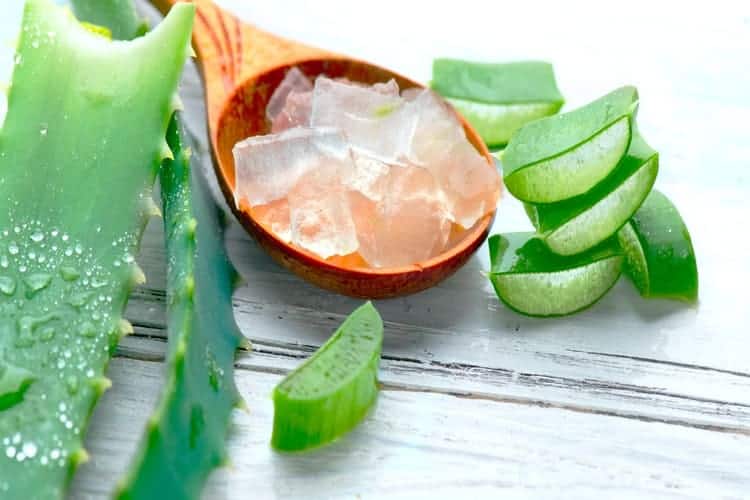
There are multiple types of exfoliants in aloe vera, including:
- Salicylic acid, a beta hydroxy acid and exfoliant that is most famous for improving acne.
- Enzymes, such as aliaise and bradykinase, that gently exfoliate the skin.
- Vitamins A, C and E.
In addition, aloe’s high water content makes it incredibly hydrating for dry or sensitive skin. Last but not least, the amino acids in aloe vera are great for softening the skin.
HOW TO USE
- Use the fresh gel as a moisturizer.
- Apply the fresh gel on your face and leave on for 15 minutes before rinsing.
- Buy aloe vera gel powder and mix it into your other DIY products. This is definitely the most convenient option. Here’s an aloe powder from Amazon that you can use.
- Be careful using aloe vera gels because they all contain thickeners and various preservatives. These are unavoidable for preserving the aloe which spoils very fast. Depending on how sensitive your skin is, it’s possible to experience an allergic reaction to some of these ingredients.
7. Rosehip Oil
The main exfoliating ingredient in rosehip oil is vitamin A. More specifically, rosehip contains beta-carotene (which the body converts to retinol) and small amounts of retinoic acid which binds to retinoic acid receptors on the skin, allowing it to work its magic when it comes to skin renewal.
One thing to note about the retinoic acid in rosehip oil is that it’s not as concentrated as the synthetic kinds that are used in many skincare products
So, any skincare benefits you get from rosehip oil are more likely coming from the totality of the ingredients, rather than the retinoic acid alone.
Furthermore, the rosehip seed is very rich in essential fatty acids, which seem to be beneficial for eczema, acne, burns and dermatitis (source).
HOW TO USE
- Layer it on top of your moisturizer or use it as a substitute for moisturizer.
- Make sure to buy rosehip oil that contains oil from the seed and the skin of the fruit. The seed contains most of the fatty acids and the skin of the fruit contains most of the vitamin A. For my top rosehip oil picks, be sure to check out this guide on choosing the best rosehip oil.
9. Diluted ACV (Apple Cider Vinegar)
ACV contains malic acid, an exfoliant that helps to improve acne and hyperpigmentation (source).
In addition, malic acid is more gentle when compared to popular chemical exfoliants, such as AHAs.
HOW TO USE
- The easiest way to get regular doses of ACV is to use it as a toner.
- ACV must be heavily diluted because it contains other acids – like acetic acid – that can irritate the skin.
- You’ll need to experiment a little to see what works for you. For myself, here’s what I find helpful:
| Daily Exfoliating ACV Toner | ½ – 1 tsp ACV and ⅓ cup water |
| Exfoliating ACV Spot Treatment | 1 part ACV to 3 parts water |
NATURAL EXFOLIANTS TO AVOID IF YOU HAVE VERY SENSITIVE SKIN
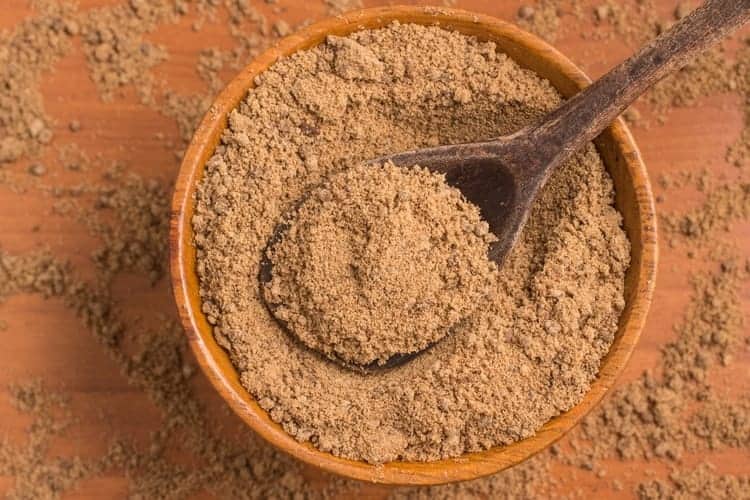
Since sensitive skin is very easily prone to irritation, it’s a good idea to avoid natural exfoliants that are likely to cut, scrape or irritate the skin in other ways. This includes exfoliants like:
- Sugar and salt: the grains are simply too big and even when using a gentle touch, they can be very abrasive.
- Baking soda: even though it looks like a fine powder, the grains feel scratchy.
- Cinnamon: cinnamon is quite potent and can be sensitizing when used topically. If you have skin that is easily irritated, you might be better off avoiding it entirely.
- Lemons: lemons contain citric acid, which is an alpha hydroxy acid that is beneficial for exfoliation. However, citric acid is also one of the stronger AHAs, making it less ideal for delicate skin.
HOW TO NATURALLY EXFOLIATE SENSITIVE SKIN AT HOME: FREQUENCY AND IN WHAT ORDER
In general, sensitive skin on the face does better with with occasional or infrequent exfoliation. This could be once a week or every two weeks. For other parts of the body – which are usually less delicate than the face – 1 to 2 times a week usually works well.
When giving yourself a complete, at-home facial, consider doing your routine in the following order:
- Cleanse with a gentle product, such as a sulfate-free soap or raw honey.
- Use a manual scrub such as oat flour (this step is optional).
- Apply a moisturizing and exfoliation mask, such as a goat milk or yogurt mask.
- Use a gentle, alcohol-free toner such as lavender tea or rose water.
- Apply a hydrating serum.
- Lock in moisture with a moisturizer or carrier oil of your choice.
NATURAL EXFOLIATING MASK FOR DELICATE, ACNE-PRONE FACE
This recipe was originally featured in my collection of diy face masks that you can use after steaming.
Ingredients
2 tablespoons honey
1 teaspoon water
2 tablespoons powdered goat’s milk
Instructions
1. Combine all the ingredients in a bowl. Mix well until you get a spreadable paste.
2. Apply the mask using a makeup brush.
3. Leave on for 10 to 15 minutes.
4. Rinse with warm water.
NATURAL OAT FLOUR BODY SCRUB FOR SENSITIVE SKIN
Ingredients
2 tablespoons oat flour
Instructions
1. Place the oat flour in a shower-safe bowl, such as a plastic bowl.
2. While in the shower, pour some of the flour into your hands and gently massage it onto wet skin.
3. Rinse off with warm water.
NOTE: the amount of oat flour in this recipe is enough for exfoliating a portion of your body, like the back of the thighs which can get rough/bumpy. Use more if you’re exfoliating your entire body.
CONCLUSION
From goat’s milk and honey, to aloe vera and rosehip oil, there are plenty of natural ingredients that can be used to get rid of dead skin on sensitive skin.
The benefit of using these ingredients is that they also nourish the skin in different ways, which helps to balance the overall health of the skin. Just make sure to practice moderation when it comes to how often you exfoliate. With sensitive skin, less is definitely more 🙂
I hope this article has given you some ideas for how you can exfoliate very delicate skin, without having to worry about harsh ingredients.
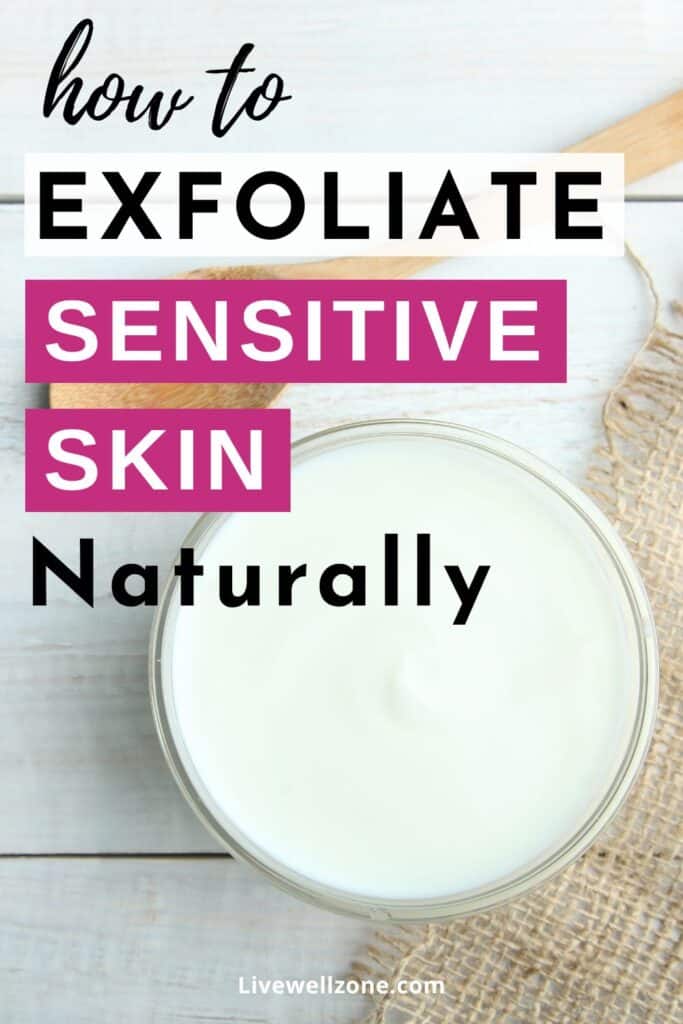
You Might Also Enjoy:
Best Vitamin C Serum For Sensitive Skin: 5 Products to Unlock Your Natural Glow
Which Is Better: Face Scrub Or Face Mask? Pros, Cons, How and When To Use
5 Things To Know Before Using Clay for Dry Skin (+ Bonus Recipe)
Best Carrier Oils for Sensitive Skin: 10 Oils To Soothe Dryness, Acne, Cracked Skin & More
7 Best Vitamin C Serums for Rosacea (To Soothe Redness and Inflammation)

